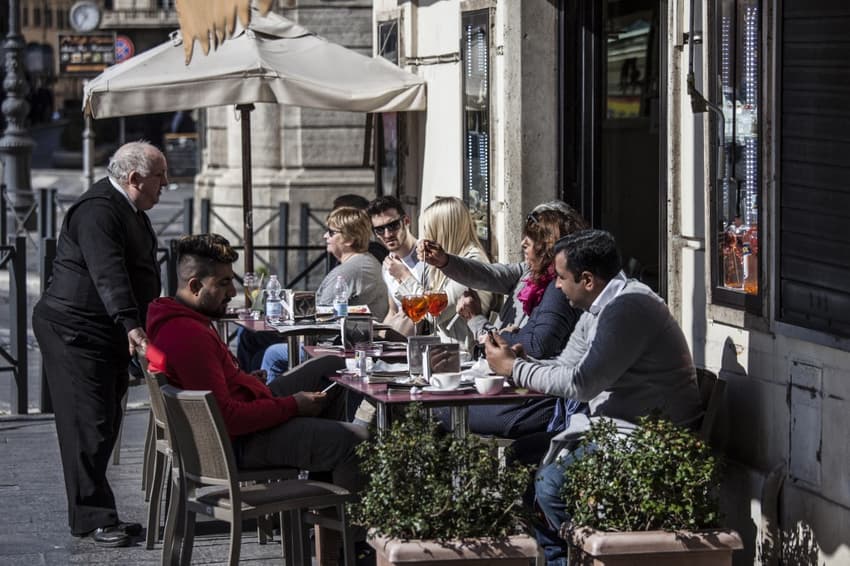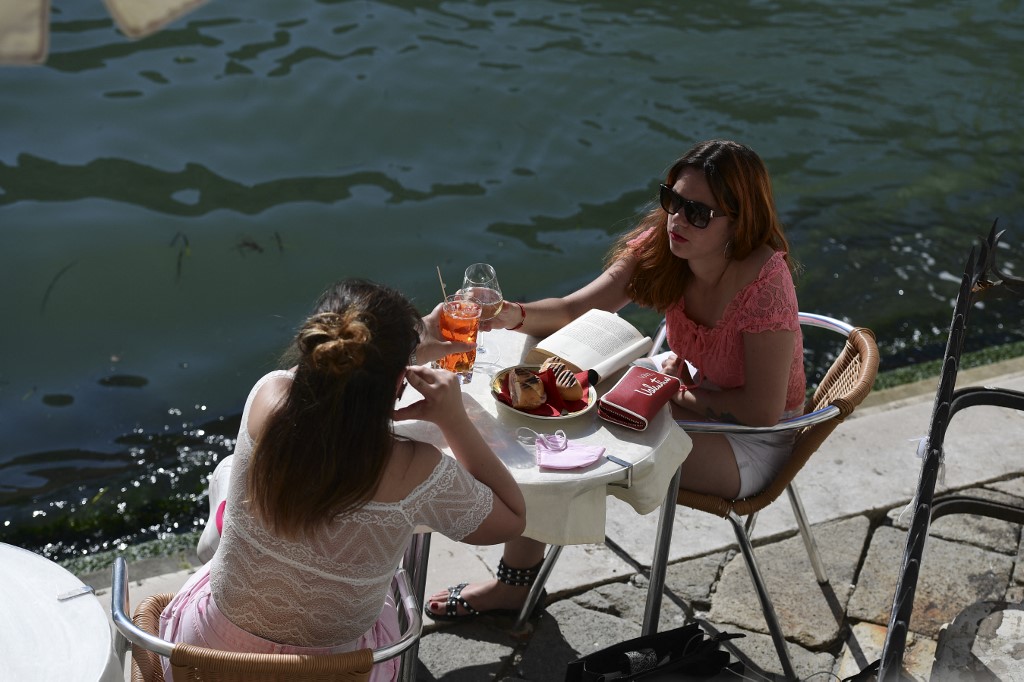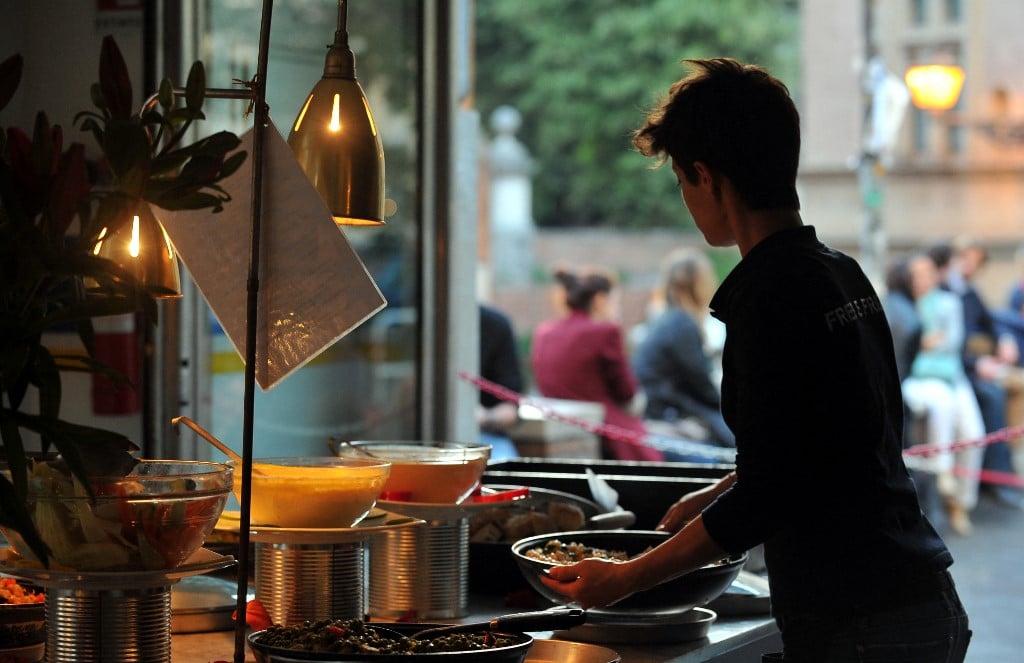Aperol and aperitivo: A guide to visiting bars and cafes in Italy

There are some unspoken rules when visiting a bar or a cafe in Italy. Here’s what you need to know.
Italy's towns and cities have a great selection of bars and cafes to explore, but it can be hard to know how to act if you're new to the country.
Here’s a guide to visiting an Italian bar or a cafe like a local.
Keep things low-key
Most Italian cafes double as bars, and vice versa, which makes sense as coffee and alcohol often go together in Italy.
The place where you go for your morning cappuccino and cornetto is the same place you can go back to in the evening for your Aperol Spritz or amaro liqueur.
READ ALSO: From spritz to shakerato: Six things to drink in Italy this summer
That means caffe-bars tend to be family friendly locales, and drinking culture is low-key - the rowdy binge-drinking that is normal in some countries doesn't exist to nearly the same extent here.
Familiarise yourself with the lingo (and culture)
It's worth knowing not just which drinks are on offer in Italy, but what they're called - which may be quite different to where you're from.
A caffe is an espresso, and a latte is just milk. A coffee in the anglophone sense is a caffe americano, with (optionally) latte. A cappuccino is considered a breakfast drink, because of the high milk content.
READ ALSO: Where, when and how to drink coffee like an Italian
Popular cocktails include the neon-orange Aperol Spritz and the more bitter, crimson Campari Spritz (which, be warned, has double the alcohol content). If you're avoiding alcohol, non-alcoholic bitters like the crodino or chinotto provide a similarly pleasant kick.

Two women enjoy a drink by Venice's Grand Canal. Photo by MIGUEL MEDINA / AFP.
Avoid 'riservato' tables
If a table is labelled riservato, that means - you guessed it - that it's reserved.
Italian bars often conveniently put the name, number of people and the reservation time on the note, so you can see how far off the reservation is.
If there's enough of a gap between the time you arrive and the next booking, most venues will let you sit at a reserved table - as long as you promise to vacate it in good time (and ask permission first!).
Enjoy an aperitivo
The culture of aperitivo, which started a few hundred years ago in Turin (though arguably dates all the way back to the Roman empire) has now spread throughout most of the Italian peninsula.
This means that at many bars you'll get a free happy hour snack along with your early-evening drink - from something as small as some olives, potato chips and peanuts to more substantial fare like bites of pizza and lasagne.
READ ALSO: Reader question: What time do people eat dinner in Italy?
Some places even offer full-blown all-you-can-eat apericena buffets, allowing you to save money by having a full dinner for the price of a single drink.

An Italian bar serves up an apericena buffet. Photo by TIZIANA FABI / AFP.
Take your cue from others
Paying for your drink in Italy can be confusing: some places want you to pay for your order at the till first and then present your receipt to the barista, while others operate in reverse order. If you're not sure which it is, just watch the other customers and follow their lead.
Be prepared to clarify whether you want your drink al banco (at the bar) or al tavolo (at the table) - in larger towns and cities, the latter typically costs quite a bit more. If you know you want a table, you can just sit straight down and someone will come to take your order.
Don't be surprised if your waiter more or less ignores you after serving you: it's considered polite in Italy to leave patrons alone to enjoy their conversation, even long after glasses have been drained and plates emptied.
Cash-carrying and tipping
Italy doesn't have much in the way of a tipping culture, though diners often leave a tip of a few extra euros at restaurants, and when ordering coffee it's standard to leave your 10 or 20 centessimi change at the bar.
It's not common to tip by card in Italy, so you might want to have some cash on you if you're feeling generous.
READ ALSO: What are the rules on tipping in Italy?
Then there's Italy's strong cash culture to account for. While it's technically compulsory for Italian businesses to accept card payments, in reality some places get around the law by having perennially 'broken' cash machines - meaning you'll be stuck if you don't have cash on you.
Comments
See Also
Italy's towns and cities have a great selection of bars and cafes to explore, but it can be hard to know how to act if you're new to the country.
Here’s a guide to visiting an Italian bar or a cafe like a local.
Keep things low-key
Most Italian cafes double as bars, and vice versa, which makes sense as coffee and alcohol often go together in Italy.
The place where you go for your morning cappuccino and cornetto is the same place you can go back to in the evening for your Aperol Spritz or amaro liqueur.
READ ALSO: From spritz to shakerato: Six things to drink in Italy this summer
That means caffe-bars tend to be family friendly locales, and drinking culture is low-key - the rowdy binge-drinking that is normal in some countries doesn't exist to nearly the same extent here.
Familiarise yourself with the lingo (and culture)
It's worth knowing not just which drinks are on offer in Italy, but what they're called - which may be quite different to where you're from.
A caffe is an espresso, and a latte is just milk. A coffee in the anglophone sense is a caffe americano, with (optionally) latte. A cappuccino is considered a breakfast drink, because of the high milk content.
READ ALSO: Where, when and how to drink coffee like an Italian
Popular cocktails include the neon-orange Aperol Spritz and the more bitter, crimson Campari Spritz (which, be warned, has double the alcohol content). If you're avoiding alcohol, non-alcoholic bitters like the crodino or chinotto provide a similarly pleasant kick.

Avoid 'riservato' tables
If a table is labelled riservato, that means - you guessed it - that it's reserved.
Italian bars often conveniently put the name, number of people and the reservation time on the note, so you can see how far off the reservation is.
If there's enough of a gap between the time you arrive and the next booking, most venues will let you sit at a reserved table - as long as you promise to vacate it in good time (and ask permission first!).
Enjoy an aperitivo
The culture of aperitivo, which started a few hundred years ago in Turin (though arguably dates all the way back to the Roman empire) has now spread throughout most of the Italian peninsula.
This means that at many bars you'll get a free happy hour snack along with your early-evening drink - from something as small as some olives, potato chips and peanuts to more substantial fare like bites of pizza and lasagne.
READ ALSO: Reader question: What time do people eat dinner in Italy?
Some places even offer full-blown all-you-can-eat apericena buffets, allowing you to save money by having a full dinner for the price of a single drink.

Take your cue from others
Paying for your drink in Italy can be confusing: some places want you to pay for your order at the till first and then present your receipt to the barista, while others operate in reverse order. If you're not sure which it is, just watch the other customers and follow their lead.
Be prepared to clarify whether you want your drink al banco (at the bar) or al tavolo (at the table) - in larger towns and cities, the latter typically costs quite a bit more. If you know you want a table, you can just sit straight down and someone will come to take your order.
Don't be surprised if your waiter more or less ignores you after serving you: it's considered polite in Italy to leave patrons alone to enjoy their conversation, even long after glasses have been drained and plates emptied.
Cash-carrying and tipping
Italy doesn't have much in the way of a tipping culture, though diners often leave a tip of a few extra euros at restaurants, and when ordering coffee it's standard to leave your 10 or 20 centessimi change at the bar.
It's not common to tip by card in Italy, so you might want to have some cash on you if you're feeling generous.
READ ALSO: What are the rules on tipping in Italy?
Then there's Italy's strong cash culture to account for. While it's technically compulsory for Italian businesses to accept card payments, in reality some places get around the law by having perennially 'broken' cash machines - meaning you'll be stuck if you don't have cash on you.
Join the conversation in our comments section below. Share your own views and experience and if you have a question or suggestion for our journalists then email us at [email protected].
Please keep comments civil, constructive and on topic – and make sure to read our terms of use before getting involved.
Please log in here to leave a comment.